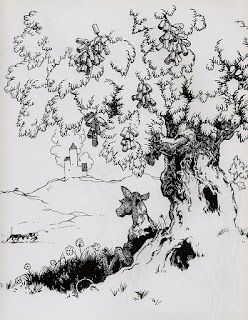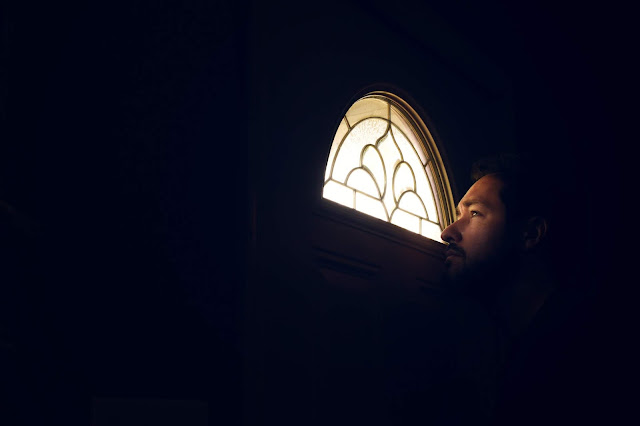Cork and Bulls
 |
| Image by A_Different_Perspective |
When I was a kid, I remember watching the original Ferdinand cartoon, and as an adult, I've seen the full-length feature film about this oddball bull. I don't, however, remember reading the book. It's a slight little thing authored by Munro Leaf, illustrated by Robert Lawson, and first published in 1936.
This week I bought a paperback reprint off of Amazon for $4.99. You know. For research.
This week I bought a paperback reprint off of Amazon for $4.99. You know. For research.
I love this little book so much. It's the beautiful, simple story of Ferdinand - "a little bull who would rather sit and smell the flowers than fight in the bullring". It smells really good, too. I take a whiff of a new paperback, and I'm transported back to being 8 years old, and the teacher is handing me a little bag with all of the new paperbacks that my Mom special ordered for me through the Scholastic book program. Anybody else? No? Just me? Cool.
For such a wee book, I actually learned a lot.
On the fourth page, there's a beautiful illustration of Ferdinand sitting under a cork tree. If you've read the book, you know that the tree is almost as big of a fixture in the book as Ferdinand himself. This tree is his spot. His sanctuary. His sentinel. His friend. Any time you see this weird little bull happy and carefree, the tree is there, too.
Something odd about the illustration, and what poked at my hiney to keep walking down this rabbit trail, is that it depicts bottle corks growing in clusters from the branches.
It hit me: although I'm a HUGE fan of drinks that come in bottles with cork stoppers, I don't have a really clear idea of where the corks actually come from. Did they… really… grow on trees like clusters of grapes?? I laughed. Surely not! I thought cork stoppers… like… came from the ocean somehow. And then other questions started to emerge, like, is wine really made from grapes?
Y'all. For a moment I was legit shook.
And I don't even USE those words.
Well, ok fine - I actually used those EXACT words the other day when I found out that before you're embalmed at the funeral home, your natural liquids and human juices are sucked out of your body and flushed down urinals - which are installed conveniently IN the embalming room. Flushed like a fish, y'all. Legit. Shook.
Back to the corks.
There are cork trees, yes. Just about every tree has an outer layer of cork, but the Cork Oak is where most of the world's cork is harvested from. These amazing earth limbs grow along the coast of the Mediterranean Sea where the conditions are perfect for growing Cork Oaks: lots of sunshine, not a lot of rain, high humidity - a pretty brutal environment for vegetation. As it turns out, Spain, the setting for The Story of Ferdinand, is among one of the top producers of cork in the whole world.
Ok, get ready. Every time you read 'cork', take a shot. Cheers!
Ok, get ready. Every time you read 'cork', take a shot. Cheers!
If you've gotten this far, and you're a little dumb like me, allow me to set the record straight: corks do not actually grow in clusters like low-hanging fruit. But that'd be pretty neat, right? Cork is a protective sheath, an outer layer of the tree that protects the separate layer of more delicate interior bark.
The Cork Oak grows in these absolutely brutal conditions, and because of the resulting crappy environmental threats (drought, brush fire, wild temperature fluctuations, etc), it grows a really thick layer of cork bark to protect itself. The cork that's harvested from these trees is lightweight, rot-resistant, fire-resistant, termite-resistant, impermeable to gas or liquids, and it's also buoyant. Nature is so cool. Anyway.
The cork is stripped from these trees in huge slabs, where they're then washed and typically punched for bottle stoppers, leaving a big slab of cork with a bunch of holes in it. Fear not and waste not, want not - the scraps are used for tile flooring, message boards, and on and on the list goes. As a bonus, when harvested responsibly, cork is a renewable resource. Stripping the cork from the Cork Oak doesn't kill the tree. In fact, cork can be harvested from these trees multiple times during its lifespan.
There were a few things that struck me when I learned this.
1. The Cork Oak is a product of its environment. Ferdinand, on the other hoof, is not. He doesn't give a flip that the other bulls are out there ripping into each other, butting heads, and acting like assholes. He's surrounded by this environment and expectation from day one: pressured to indulge in the normalcy of bullish behavior. You'd expect over time that he might develop his own protective cork layer to survive, to fend off the bullies, the mockers, the naysayers. But he doesn't. He's gentle, sweet, observant - content with his weird world, who he is and what he wants in life.
2. Both the Cork Oak and Ferdinand are primarily valued based on their external qualities. The oak for its cork, the bull for its brute force. But (y'all I apologize in advance for the cliche) it's what's on the inside that counts. Both Ferdinand and the Cork Oak are gentle, delicate, resilient, content, and their strength really does begin and end with the interior corridors of their unique nature.
Without these unique and steadfast interiors, there'd be no story about Ferdinand. There'd be no cork. It's what sustains both of these creatures.
It's what sustains us.


